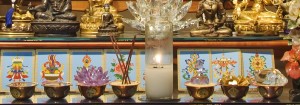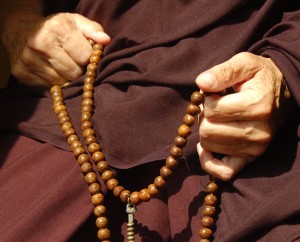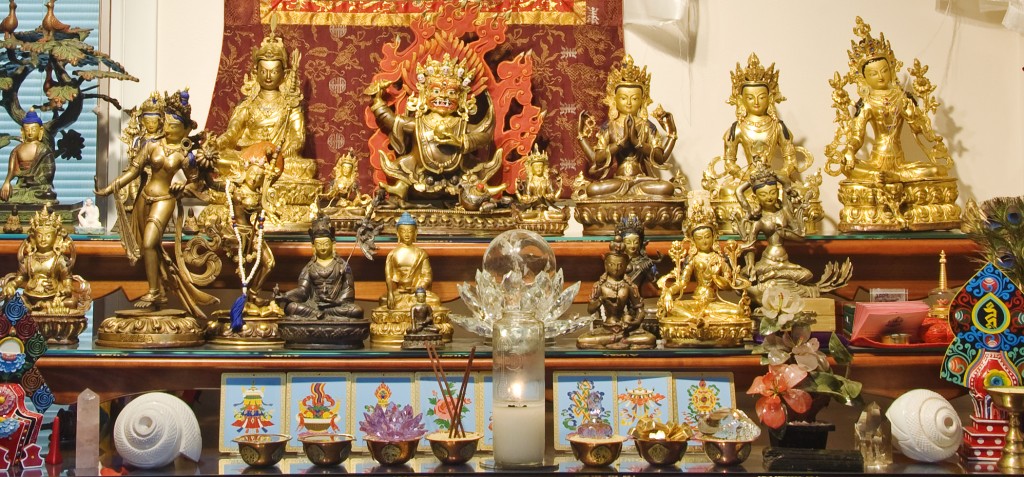What is an Altar?
In Buddhism, an Altar is a physical display and support for one’s practice. The Altar is a sacred space dedicated to images representing one’s faith, devotion, and respect. It is also a place to make offerings of gratitude for our precious opportunity: for the Path which can lead us out of suffering, for the method which can lead us to Enlightenment.
On a deeper level, the Altar is a representation of the goal of the Path. The images of the Buddha are reminders that it is possible to accomplish the Method and achieve Enlightenment. Each of the Buddhas started out just as we are now, as ordinary beings with a sincere wish to seek Enlightenment for the sake of all sentient beings. As we view the Altar, we are reminded that this goal is attainable.
The Altar also helps us to train in mindfulness. The Path is about waking up from our deep sleep of non-recognition. As we view the altar with faith and devotion, we recognize what is truly extraordinary and what is merely ordinary. Increasing our awareness helps us to cultivate our pure intention to be of benefit to all sentient beings.
How to set up an Altar
There are many types of Altars. They can be elaborate or simple, but most important is pure motivation. Otherwise, the benefit is minimal.
An Altar has at least two levels. The images of the Buddha––pictures, statues, etc.––are placed on the highest level. The lowest level is for offerings. Traditionally, eight offerings are placed on an altar: water for drinking, water for bathing, flowers, incense, light, scent or perfume, food, and music. They represent what one traditionally offered to guests in one’s home. In the days before motels and inns, travelers would rely on the kindness of strangers in their homes to provide shelter and food. This is still the case in many remote areas of Tibet.

Offering 1 – A bowl filled with water representing clean water for drinking is offered to the Buddha. It symbolizes all auspicious, positive causes and conditions.
Offering 2 – A bowl filled with water represents clean water for bathing the Buddha’s feet. It symbolizes purification.
Offering 3 – A bowl filled with flowers represents the beauty of the Buddha’s Enlightenment. It symbolizes an open heart and the practice of generosity. (The bowl can be filled with rice and topped with a silk flower. If fresh flowers are used, the bowl is filled with water.)
Offering 4 – A bowl of rice with incense placed on top symbolizes moral ethics and discipline.
Offering 5 – Light of some kind, a candle or butter lamp, is offered to the Buddha’s eyes and is symbolic of patience and a stable mind that dispels ignorance.
Offering 6 – A bowl of scented water symbolizes joyful, enthusiastic effort and perseverance. (Or a bottle of fragrance can be placed on top of a bowl of rice.)
Offering 7 – A bowl filled with rice with delicious food on top represents the precious nectar of the Path that leads to Enlightenment.
Offering 8 – A bowl filled with rice and topped with a representation of music (such as a conch shell, cymbals, or bells) is offered to the Buddha’s ears and symbolizes the nature of Wisdom.
Please Note: One can simply offer a light and seven bowls of water in place of the above offerings.
How to Open and Close an Altar
An altar is opened and closed in a specific way. One opens the altar by pouring water into the bowls in a steady, even way, beginning at the far left and moving to the right. The bowls should be lined up very straight and evenly spaced, about the width of a grain of rice apart.
When the Altar is closed, it is done in reverse: the water bowls are emptied starting from the right. The bowls are dried and turned over, as one meditates on impermanence. Then the merit is dedicated to all sentient beings.
The bowls that contain substances may be left untouched. But make sure the offerings remain fresh. For example, if offering fruit, remove it when it shows the first sign of deterioration.
The offering water may be disposed of outside in a clean place, or it may be used to water a plant. The food offerings may be eaten after they are removed from the Altar. Since this is blessed food, it should be treated with mindfulness and respect.
Offering Verses
One may recite offering verses when an Altar is opened. Jetsunma has suggested that RAM YAM KAM may be used when the offering is made, followed by OM AH HUNG. RAM YAM KAM represents the ordinary elements, and OM AH HUNG represents the transformation of the ordinary into the extraordinary.
How to Maintain an Altar
The inner posture of maintaining an Altar is the same as if one were caring directly for the Buddha or one’s Root Guru. Treat the Altar with great respect and love, for it represents the precious vehicle by which it is possible to end suffering and achieve the awakened state of Enlightenment. Keep the Altar and everything on it clean, orderly, and fresh.
Miscellaneous Information Regarding Offerings
We make offerings to the Buddhas and Bodhisattvas not because they need them, but for our own benefit, to accumulate merit and wisdom. Offerings are a simple, beautiful way to do what will eventually lead to our awakening.
Traditionally, one does not offer anything sour such as lemons or limes on the Altar, or any of the foods considered “dark,” such as garlic.
If a mala is offered on the Altar, it is usually placed on the foot of the Deity or at the base of the statue. Once a mala has been offered, it is no longer appropriate for personal use.





